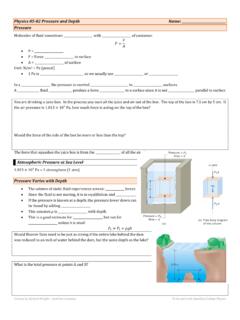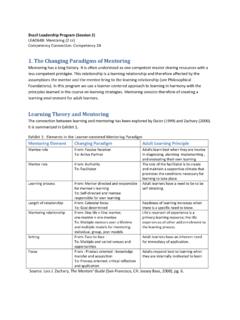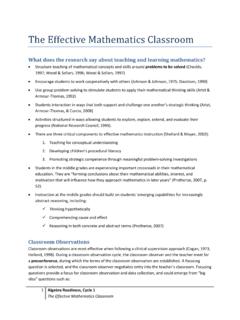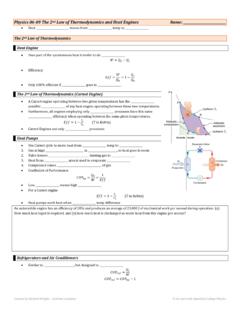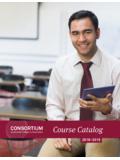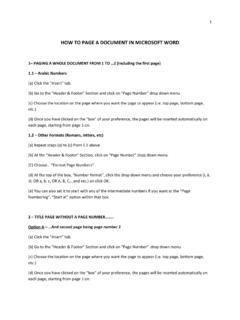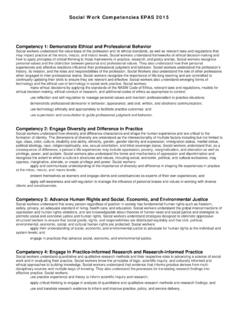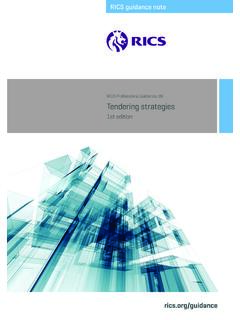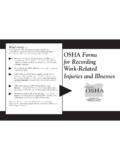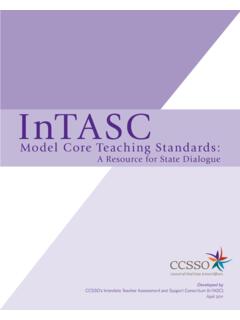Transcription of Danielson's Framework for Professional Practice
1 A Framework for Professional Practice Any Framework developed for Professional Practice must provide guidelines on what a teacher does when teaching. Thus, to better understand the responsibilities of teachers, this course will incorporate the following Framework for Professional Practice . Charlotte Danielson developed this Framework . Danielson s Framework for Teaching Danielson s Framework for teaching identifies aspects of a teacher s responsibilities that empirical studies have demonstrated as promoting improved student Because teaching is an extremely complex activity, this Framework is useful in laying out the various areas of competence in which Professional teachers need to develop expertise.
2 Danielson divides the complex activity of teaching into twenty-two components clustered into four domains of teaching responsibility: (1) planning and preparation, (2) the classroom environment , (3) instruction, and (4) Professional responsibilities. These domains and their components are outlined in a following table. A brief review of each of these domains will provide a road map of the skills and competencies new teachers need to develop. Domain 1: Planning and Preparation. The components in Domain 1 outline how a teacher organizes the content of what students are expected to learn---in other words, how the teacher designs instruction.
3 These include demonstrate knowledge of content and pedagogy, demonstrating knowledge of the students, selecting instructional goals, demonstrating knowledge of resources, designing coherent instruction, and assessing student learning Domain 2: The classroom environment . The components in Domain 2 consist of the interactions that occur in a classroom that are non instructional. These consist of creating an environment of respect and rapport among the students and with the teacher, establishing a culture for learning, managing classroom procedures, managing student behavior, and organizing the physical space.
4 1 From Charlotte Danielson, Enhancing Professional Practice : A Framework for Teaching, Association for Supervision and Curriculum Development, 1996, Reprinted by permission of the author. Domain 3: Instruction. The components in Domain 3 are what constitute the core of teaching the engagement of students in learning contest. These include communicating clearly and accurately, using questioning and discussion techniques, engaging students in learning, providing feedback to students, and demonstrating flexibility and responsiveness.
5 Domain 4: Professional Responsibilities. The components in Domain 4 represent the wide range of a teacher s responsibilities outside the classroom. These include reflecting on teaching, maintaining accurate records, communicating with families, contributing to the school and district, growing and developing professionally, and showing professionalism. Teachers who demonstrate these competencies are highly valued by their colleagues and administrators, as well as being seen as true professionals. The benefits of having a Framework for Professional Practice , as Danielson notes, are several.
6 First, a Framework offers the profession of teaching a shard vocabulary as a way to communicate about excellence. For novice teachers, a Framework provides a pathway to excellence by laying out the twenty-two important components that constitute Professional Practice . A Framework for teaching provides a structure for discussions among teachers and also serves to sharpen the focus for Professional development. A Framework also serves to communicate to the larger community the array of competencies needed to be an effective teacher.
7 Figure A Framework for teaching Components of Professional Practice Domain 1: Planning and Preparation Component 1a: Demonstrating Knowledge of Content and Pedagogy Knowledge of content Knowledge of prerequisite relationships Knowledge of content-related pedagogy Component 1b: Demonstrating Knowledge of Students Knowledge of characteristics of age group Knowledge of students varied approaches of learning Knowledge of students skills and knowledge Knowledge of students interests and cultural heritage Component 1c: Selecting Instructional Goals Values Clarity Suitability for diverse students Balance Component 1d: Demonstrating Knowledge of Resources Resources for teaching Resources for students Component 1e: Designing Coherent Instruction Learning activities Instructional materials and resources Instructional groups Lesson and unit structure Component 1f: Assessing Student Learning Congruence with instructional goals Criteria and standards Use for planning Components of Professional Practice (continued) Domain 2.
8 The Classroom environment Component 2a: Creating and environment of Respect and Rapport Teacher interaction with students Student interaction Component 2b: Establishing a Culture for Learning Importance of the content Student pride in work Expectations for learning and achievement Component 2c: Managing Classroom Procedures Management of instructional groups Management of transitions Management of materials and supplies Performance of non instructional duties Supervision of volunteers and paraprofessionals Component 2d: Managing Student Behavior Expectations Monitoring of student behavior Response of student misbehavior Component 2e: Organizing Physical Space Safety and arrangement of furniture Accessibility to learning and use of physical resources Domain 3: Instruction Component 3a: Communicating Clearly and Accurately Directions and procedures Oral and written language Component 3b: Using Questioning and Discussion Techniques Quality of questions Discussion techniques Student participation Component 3c.
9 Engaging Students in Learning Representation of content Activities and assignments Grouping of students Instructional materials and resources Structure and pacing Component 3d: Providing Feedback to Students Quality: accurate, substantive, constructive, and specific Timeliness Component 3e: Demonstrating Flexibility and Responsiveness Lesson adjustment Response to students Persistence Domain 4: Professional Responsibilities Component 4a: Reflecting on Teaching Accuracy Use in future teaching Component 4b: Maintaining Accurate Records Student completion of assignments Student progress in learning Non instructional records Component 4c: Communicating with families Information about the instructional program Information about individual students Engagement of families in the instructional program Component 4d: Contributing to the School and District Relationships with colleagues Service to the school Participation in school and district projects Component 4e.
10 Growing and Developing Professionally Enhancement of content knowledge and pedagogical skill Service to the profession Component 4f: Showing Professionalism Service to students Advocacy Decision making

